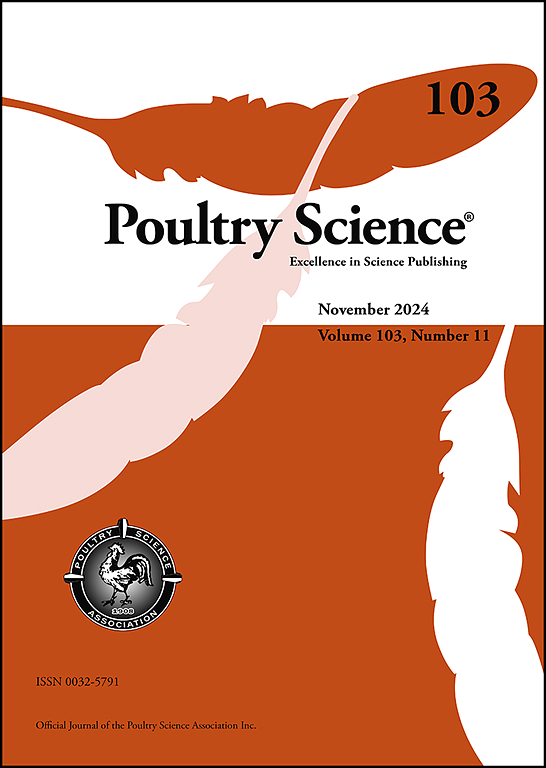Impacts of an energy sparing feed additive on turkeys fed titrating reduced energy diets
IF 3.8
1区 农林科学
Q1 AGRICULTURE, DAIRY & ANIMAL SCIENCE
引用次数: 0
Abstract
Providing amino acids, energy, and minerals are costly dietary components in formulating diets for turkeys, with corn, soybean meal, and oils being of utmost interest due to their percent inclusion levels. In addition, the highest feed consumption occurs in the grower-finisher (GF) phase of production making diet formulation during this period of growth critically important. Reducing feed cost through reductions in expensive energy sources (e.g., fats) in a turkey diet while maintaining performance and carcass traits could greatly benefit turkey production profitability. The current study evaluated the effects of the addition of a commercial energy sparing feed additive (Enercore®, Biosen LLC) in a series of reducing energy diets. Dietary treatments included a commercial control diet (CON) and 3 experimental diets with different levels of reduced Kcal to equal a 50 Kcal/kg deficit (ESFA 1), 70 Kcal/kg deficit (ESFA 2), and 100 Kcal/kg deficit (ESFA 3) with the inclusion of 1 kg/tonne of Enercore. At placement, 1,800 male turkeys were evenly placed across dietary treatments (n = 8 per treatment) and provided their dietary treatment through 18 wk of age. Body weights and feed weights were taken every 5 wk and before loadout. At 17 wk of age, one tom per pen was weighed and euthanized to determine breast yield and deboned thigh yield. Body weights and mortality percent were similar across diets at the end of 18 wk of age (P > 0.140). Whereas, mortality-adjusted FCR was altered with dietary treatment with toms fed ESFA 2 having the lowest mortality-adjusted FCR (P < 0.001) compared to all other dietary treatments. For carcass measurements, live weights of birds sampled, breast yield, and deboned thigh yield were similar between treatments (P > 0.220). In conclusion, removal of 50 and 70 Kcal/kg of energy in turkey diets supplemented with an energy sparing feed additive did not significantly alter body weight or carcass yield but only the removal of 70 Kcal/kg with the ESFA, Enercore®, improved feed conversion.
求助全文
约1分钟内获得全文
求助全文
来源期刊

Poultry Science
农林科学-奶制品与动物科学
CiteScore
7.60
自引率
15.90%
发文量
0
审稿时长
94 days
期刊介绍:
First self-published in 1921, Poultry Science is an internationally renowned monthly journal, known as the authoritative source for a broad range of poultry information and high-caliber research. The journal plays a pivotal role in the dissemination of preeminent poultry-related knowledge across all disciplines. As of January 2020, Poultry Science will become an Open Access journal with no subscription charges, meaning authors who publish here can make their research immediately, permanently, and freely accessible worldwide while retaining copyright to their work. Papers submitted for publication after October 1, 2019 will be published as Open Access papers.
An international journal, Poultry Science publishes original papers, research notes, symposium papers, and reviews of basic science as applied to poultry. This authoritative source of poultry information is consistently ranked by ISI Impact Factor as one of the top 10 agriculture, dairy and animal science journals to deliver high-caliber research. Currently it is the highest-ranked (by Impact Factor and Eigenfactor) journal dedicated to publishing poultry research. Subject areas include breeding, genetics, education, production, management, environment, health, behavior, welfare, immunology, molecular biology, metabolism, nutrition, physiology, reproduction, processing, and products.
 求助内容:
求助内容: 应助结果提醒方式:
应助结果提醒方式:


